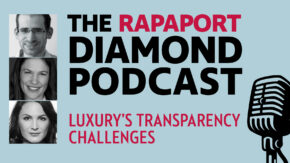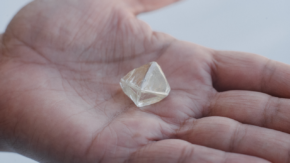It is time to dispel the cloud of misinformation that surrounds fluorescent diamonds and get a clear understanding of this wondrous natural effect that adds even more mystique to natural diamonds.
1. FLUORESCENT DIAMONDS ARE RARE
Only up to 35% of diamonds display some level of fluorescence, according to the GIA. However, in the majority of cases there is no noticeable impact on appearance. Indeed, 94% of all diamonds submitted to AGS Laboratories had negligible fluorescence. The lab also found that ‘very strong’ fluorescence appeared in just 0.34% of diamonds it graded, while ‘medium’ and ‘strong’ effects were exhibited in 3.6% and 1.5% of all stones respectively.
2. FLUORESCENT DIAMONDS CONTAIN A SECRET
Fluorescence is the ability of a diamond to glow under some conditions. So, to the natural eye such diamonds appear just like other diamonds. However, when they are exposed to UV light, in a dance club for example, or bright sunlight they will fluoresce. Once the light source is removed the diamond will return to normal. Given this trait they have often been referred to as ‘disco diamonds’.
3. DIAMONDS CAN FLUORESCE IN A VARIETY OF COLORS
While blue is by far the most common color, diamonds can fluoresce in a spectrum of colors ranging from orangey yellow, yellow, orange, red, white and green. The difference in color is caused by variations deep within the diamonds atomic structure, such as the number of nitrogen atoms present.
4. DIAMOND FLUORESCENCE APPEARS ON GRADING REPORTS
While fluorescence is not one of the 4Cs (color, clarity, cut and carat weight), it is considered a significant identifying characteristic that can distinguish one diamond from another. The GIA, for example, rates the intensity of a diamond’s fluorescence as: None, Faint, Medium, Strong, Very Strong. If the grading report describes the fluorescence as Medium, Strong or Very Strong, it will also note the color of the fluorescence.
5. CONSUMERS WOULD CONSIDER PURCHASING FLUORESCENT DIAMONDS
While 74% of consumers in the US are either poorly informed or lack any knowledge regarding fluorescent diamonds, once educated, over 82% would consider buying a diamond with such a feature, according to research by Gfk market research agency. The research conducted among over 4,000 jewelry consumers also found that almost 60% of customers, mostly Millennials, expressed a willingness to pay as much as 15% more for a fluorescent diamond.
6. THE WHOLESALE DIAMOND MARKET IS FULL OF MISCONCEPTIONS
While the majority of consumers are not aware of the phenomenon of fluorescence, the diamond wholesale market is dominated with unfounded and untrue perceptions of this natural marvel found in some diamonds. The main misconception is that fluorescence causes a milky appearance. This belief has been discredited and disproved untrue by scientific research which has shown that fluorescence either has a neutral impact or can actually improve the appearance of polished diamond characteristics.



